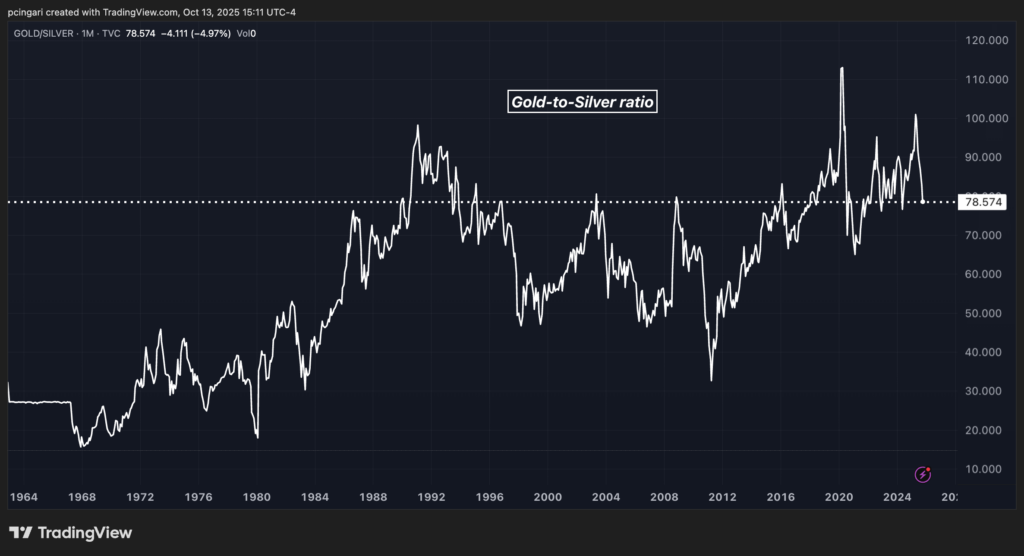
Silver is staging one of its strongest rallies in over a decade, surging to a fresh all-time high of $52 per ounce on Monday, up another 3% on the day and an eye-popping 80% year-to-date — its best performance since 2010.
And yet, analysts say the white metal still hasn't caught up with gold.
Despite both metals ripping higher and gold, which is tracked by the SPDR Gold Shares (NYSE:GLD), reaching a record $4,100/oz, the gold-to-silver ratio remains stubbornly high at 78, meaning it takes 78 ounces of silver to buy one ounce of gold.
That's far above the levels seen in past precious metal bull markets, suggesting silver may still be significantly undervalued.
Chart: Gold-Silver Ratio Still Has Room To Fall

What Is The Gold-Silver Ratio And Why It Matters
The gold-silver ratio is a classic tool used by traders and analysts to measure relative value between the two metals. When the ratio is high, silver is relatively inexpensive compared to gold. When it drops, silver gains ground.
Over the last five years, the ratio has ranged from a low of 60 in February 2021 to a high of 100 in April 2025, amid recession fears and heavy demand for gold as a safe haven.
Today's level of 78 is down from that peak, but still well above the long-term average, and miles away from the lows seen in previous secular bull runs.
In January 1980, during a speculative rush into metals, the ratio plunged to just 15. Again in April 2011, during the post-crisis recovery, it dropped to 30. In both cases, silver significantly outperformed gold, closing the valuation gap.
Analysts Say Silver Is Still Undervalued
Garrett Goggin, CFA and CMT, and founder of Golden Portfolio, sees massive upside in silver when measured against historical valuation trends.
"In 1980, silver traded at an 80% premium based on a regression to the gold price. In 2011, it traded at a 70% premium. Now, silver trades at a 3% discount to gold. Fair value remains about 70% higher at $86 per ounce," Goggin said in a post on social media X. "Probability and math suggest we still have a long way to go."
This argument is based on regression analysis, which examines historical pricing relationships between gold and silver and how far current prices deviate from this trend.
Right now, the gap is wide — and in Goggin's view, unsustainable.
Bank of America Also Sees More Room To Run
Bank of America's metals research team also sees an upside for silver. On Monday, the bank raised its 2026 silver target to $65/oz, with an average of $56.25/oz, marking a 29% upward revision from its previous forecasts.
Despite predicting an 11% decline in silver demand next year, primarily due to efficiency gains in solar technology, BofA still expects the market to remain in deficit. Since 2021, mine supply has been unable to keep pace with industrial and investment demand, resulting in structural tightness.
More importantly, physical market dislocations are amplifying volatility.
"Dislocations have been severe on the physical silver market," BofA said, citing the transfer of ounces to New York in anticipation of tariffs that never materialized, which tightened the London market and spiked lease rates.
While the bank warns of short-term volatility if those dislocations unwind, the broader trend remains bullish. "We see the risk of a correction near-term, but still expect further upside in 2026," they wrote.
The Silver Discount Won't Last Forever
With silver up 80% this year and gold climbing steadily alongside it, some might think the trade has already played out. But the gold-silver ratio tells a different story.
Historically, this ratio narrows sharply in precious metal bull cycles — and we're still far from those historical compression points.
In past cycles, the ratio bottomed at 15 to 30. Today, it sits at 78. For silver to return to even a 40 ratio at current gold prices, it would need to trade near $100/oz — nearly double where it stands now.
So while silver – as tracked by the iShares Silver Trust (NYSE:SLV) – may no longer be "cheap" in nominal terms, its relative value compared to gold suggests it's still got plenty of runway left.
Read now:
Photo: Shutterstock







